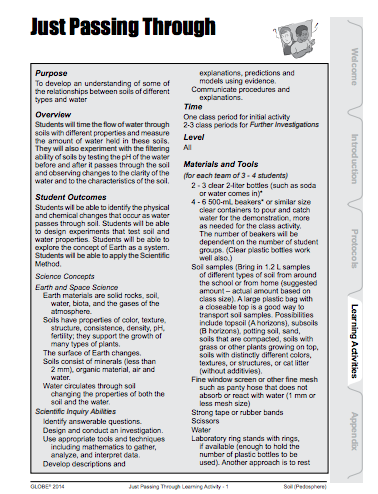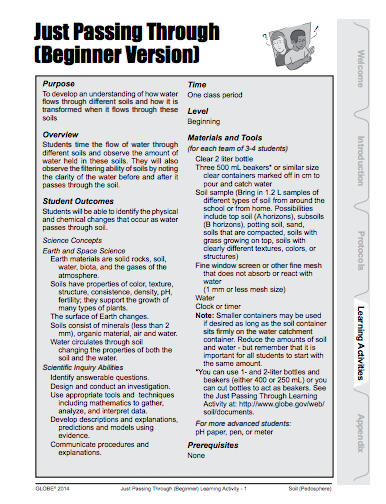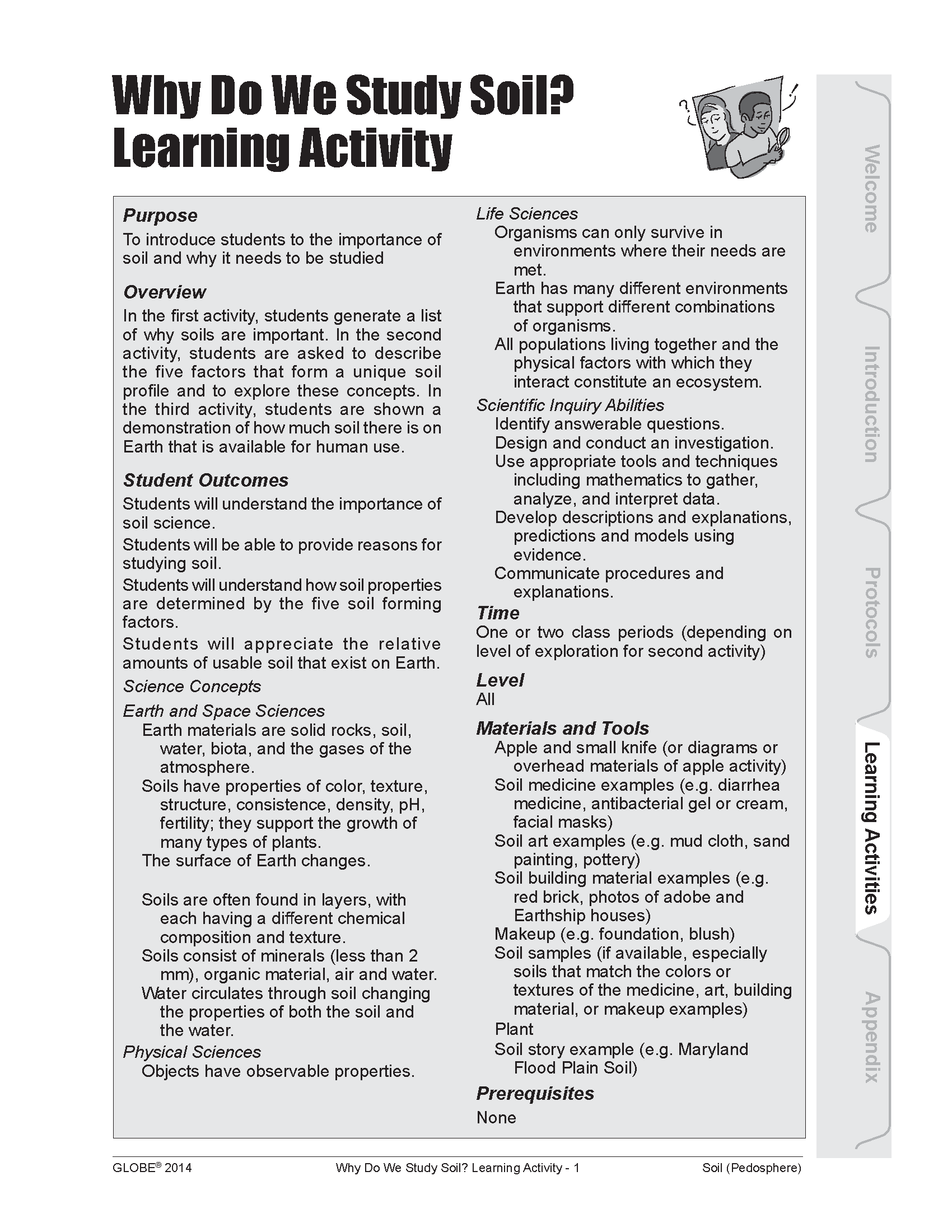GLOBE Connections
GLOBE Connections: Soil Moisture
GLOBE protocols and learning activities that complement the Deforestation phenomenon through hands-on investigations are detailed below. Students can conduct their own investigations and see how their data related to global patterns by using GLOBE and My NASA Data together.
Visit the GLOBE Geosphere Protocols & Related ESDE Datasets page that outlines the datasets available in the Earth System Data Explorer. These data complement student GLOBE investigations using the following protocols.
Soil Moisture
Protocols
GLOBE protocols can be used to collect many types of data to examine tree cover and deforestation. Students can use the protocols to collect data and share their data with other GLOBE students around the world. As scientists continue their study of deforestation, they can use these data.
Soil Infiltration
Students will use a dual ring infiltrometer that they can construct from large food container cans to measure the rate at which water soaks into the soil during a roughly 45-minute period.
Soil Moisture
There are several GLOBE protocols for soil moisture. This gives students more than one way to determine soil moisture.
- Gravimetric: Students will measure soil water content by comparing the wet and dry masses of samples.
- SMAP Block Pattern: Students will obtain in situ measurements of soil moisture that are consistent with soil moisture measurements from the Soil Moisture Active Passive (SMAP) satellite.
- Sensors: Students will develop a calibration curve and use it to determine soil water content at depths of 10 cm, 30 cm, 60 cm, and 90 cm from meter readings of four soil moisture sensor blocks.
Protocol Bundles
These protocol bundles are related to soil moisture.
1. ENSO Protocol Bundle - This bundle includes atmosphere, hydrosphere, and pedosphere protocols that are used for the GLOBE ENSO (El Niño Southern Oscillation) Campaign which has been formulated to engage students in determining where and how much El Niño affects local places and to put students in contact with the resulting patterns in their local environment.
2. Rivers and Lakes Protocol Bundle - The purpose of the Rivers and Lakes Protocol Bundle is to group GLOBE protocols that may provide students with the knowledge and ideas of various interactions happening in their local rivers and lakes.
3. Soil Protocol Bundle - The purpose of the Soil Bundle protocol is to provide greater knowledge on the relationship between soil characteristics and their function for different ecosystems.
4. Water Cycle Protocol Bundle - The Water Cycle is a key part of the Earth system. The fluxes and reservoirs that comprise it vary over time and space. The data you collect can help characterize the cycle in your area. This bundle contains atmosphere, hydrosphere, and pedosphere protocols.
5. Water Quality Protocol Bundle - As water interacts with the atmosphere, soil and the surrounding land cover bordering water bodies, and the surface over which the water flows, the water quality changes. Water quality determines what can live in the water body and how the water may be used. This bundle contains atmosphere, hydrosphere, and pedosphere protocols.
Learning Activities
Check out the three learning activities to help prepare students for collecting data and to support the integration of MND with GLOBE in your curriculum. These activities will provide students with a hands-on experience to guide their understanding of the properties of soil that affect the amount of moisture it will hold.
Soils as Sponges: How Much Water Does Soil Hold?
Overview: Students determine the moisture content of a sponge after squeezing the water out of the sponge, and allowing water to evaporate from the sponge. Students also measure the amount of water that has evaporated from the soil samples.
Student Outcomes:
- Students will understand that objects can hold a measurable amount of water.
- Students will be able to transfer this concept to soil by weighing wet and dry soil samples and calculating the amount of water held by the soil.

Just Passing Through
Overview: Students will time the flow of water through soils with different properties and measure the amount of water held in these soils. They will also experiment with the filtering ability of soils by testing the pH of the water before and after it passes through the soil and observing changes to the clarity of the water and to the characteristics of the soil.
Student Outcomes:
- Students will be able to identify the physical and chemical changes that occur as water passes through the soil.
- Students will be able to design experiments that test soil and water properties. Students will be able to explore the concept of Earth as a system.
- Students will be able to apply the Scientific Research Process

Just Passing Through (Beginners Version)
Overview: Students time the flow of water through different soils and observe the amount of water held in these soils. They will also observe the filtering ability of soils by noting the clarity of the water before and after it passes through the soil.
Student Outcomes:
- Students will be able to identify the physical and chemical changes that occur as water passes through soil.

Overview: Introduce students to the importance of soil and why it needs to be studied.
Student Outcomes:
- Understand the importance of soil science
- Be able to provide reasons for studying soil
- Understand how soil properties are determined by the five soil forming factors
- Appreciate the relative amounts of usable soil that exist on Earth
- Soils have properties of color, texture, structure, consistence, density, pH, fertility; they support the growth of many types of plants
- The surface of Earth changes

